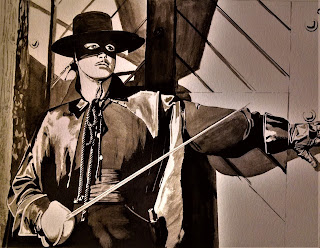LEGENDARY HEROES
#1 IN A SERIES
ZORRO
Zorro's first appearance came in 1919 in the pages of the pulp magazine All-Story Weekly. It was a serialized novel that ran from August 9 to September 6 in five installments and was written by Johnston McCulley (1883-1958). McCulley was born in Ottawa, IL and raised in Chillicothe, IL before becoming a crime reporter for the police gazette. He turned to the pulps where he wrote adventure stories, and wrote about a dozen screenplays for Hollywood movies. McCulley created several recurring pulp characters, including the Spider, but his greatest creation Zorro was only intended to be a one-time appearance.
"The Curse of Capistrano" was Zorro's origin story in All-Story Weekly and was read by Douglas Fairbanks, the swashbuckling actor, while on his honeymoon with Mary Pickford. He and Pickford had just formed their own movie studio, United Artists, with Charlie Chaplin and D. W. Griffith, and decided upon this pulp adventure story as the inaugural film for their studio. The serialized story was adapted for the 1920 film "The Mark of Zorro" and was a huge success, thus prompting author McCulley to write more Zorro stories. Over the next 40 years Zorro would appear in 5 serialized novels and 57 short stories. When "The Curse of Capistrano" was published in hardcover years later it would become one of the bestselling novels of all time, selling 50 million copies.
Zorro was one of the earliest examples of a fictional masked avenger with a secret identity and was a precursor to comic book heroes like Batman. Zorro wore a signature costume of all black with a cape, a hat, and a mask that covered the upper portion of his face. Zorro's weapon of choice was a rapier that he used to carve the initial "Z" with three quick strokes into his defeated foes. He resided in a huge hacienda filled with secret passages and tunnels that led to a cave that he called "the Fox Den", and it became his base of operations and where he concealed his trusty steed, a jet black horse named Tornado.
Zorro was actually Don Diego de la Vega, the only son of Don Alejandro de la Vega, the wealthiest landowner in Spanish California of the early 1800s. Don Diego was attending university in Spain, where he acquired his skill as a swordsman, when he was suddenly summoned home by his father. California had come under the control of an oppressive dictator. Set in the Pueblo of Los Angeles in Alta, California, Zorro fought against tyrannical officials and assorted villains while defending the commoners and indigenous people of California. Zorro soon had a bounty on his head imposed by the corrupt politicians that he publicly humiliated. Zorro was too skilled and cunning to be caught by the bumbling authorities and he was revered by the townspeople who gave him the name "el Zorro" which was Spanish for "Fox". In order to divert suspicion from his true identity Don Diego concealed his sword fighting ability and pretended to be a wealthy, cowardly fop.
The popularity of Zorro was astounding. The character was featured in over 40 films and 10 television series, portrayed by actors like Douglas Fairbanks, Reed Hadley, Tyrone Power, Frank Langella, George Hamilton, Anthony Hopkins, Antonio Banderas, Alain Delon, Clayton Moore, Guy Stockwell, and Sean Flynn. The most famous portrayal, and my personal favorite, was by Guy Williams in the Disney produced TV series that ran from 1957-1959. Guy Williams (1924-1989) was born Armando Joseph Catalano in New York City and his version of Zorro brought him international fame. He went onto another successful TV series in the 1960s called "Lost in Space" as the patriarch of the Robinson family before retiring in Argentina where he died.
"The Adventures of Zorro" appeared on radio in 1957. Dell comics published Zorro comic books from 1948-1957 with artwork by noted illustrator Everett Raymond Kinstler. With the appearance of the Disney TV show in 1957 Dell began producing comic books with a tie-in to the series with artwork by Alex Toth. There were 5 animated cartoon series beginning in 1981, a daily comic strip that was launched in the late 1990s, and 65 separate theatrical performances that featured the masked hero. Bold Venture Press has collected all of the sixty-plus stories by Johnston McCulley and reprinted them in a 6 volume collection. As an interesting side note, the cave that was used in various Zorro productions is preserved and known as "the Zorro Cave". Located in Chatsworth, California, it is hidden behind a condominium complex. The land was once the property of the Iverson Movie Ranch, the most widely filmed outdoor location in the history of Hollywood.
I created the picture of Zorro using pen, brush & ink on watercolor paper. For more examples of my artwork you can visit instagram.com/gregclarknoirart, pinterest.com/gregclarknoirart, or purchase my artwork on ebay.com/usr/noir*art.

.jpg)

.jpg)
Comments
Post a Comment